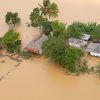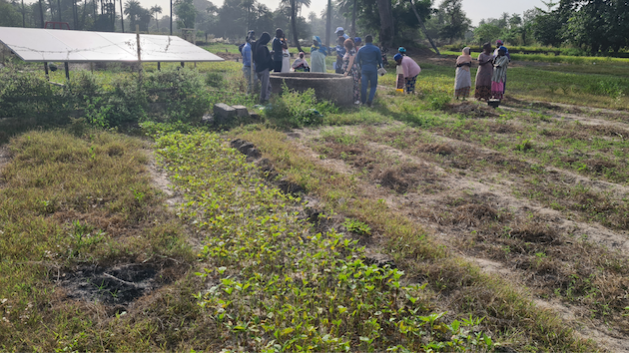Writer and Web page data
- This web page: https://www.globalissues.org/article/805/cop20-lima-climate-conference.
- To print all data (e.g. expanded aspect notes, reveals various hyperlinks), use the print model:
On this web page:
Introduction
 December 1 – 14, 2014, Lima, Peru was the venue for the twentieth annual United Nations Local weather Change Convention, also called the twentieth Convention of the Events — or COP 20.
December 1 – 14, 2014, Lima, Peru was the venue for the twentieth annual United Nations Local weather Change Convention, also called the twentieth Convention of the Events — or COP 20.
The aim of this convention was to create a common settlement on local weather change motion and start the method of financing mitigation.
Assembly consequence
The assembly ended with all nations agreeing to chop again greenhouse fuel emissions. Often known as the Lima Accord, this treaty is just not legally binding and international locations don’t have to specify how a lot they’ll reduce, as an alternative agreeing to report their plans again by March 2015.
Whereas for a lot of it appeared like a profitable consequence, others have been upset, reminiscent of poor international locations struggling to rebuild from present impacts of local weather change who have been alarmed on the disappearance of loss and injury commitments from the ultimate textual content which has been a part of the dialogue for years.
The worldwide local weather motion, 350.org, summarized the disappointments and hopeful features of the assembly consequence, noting
- The brand new settlement doesn’t replicate the urgency of the local weather disaster
- Some good agreements – however no measures to make sure implementation
- Least developed and susceptible nations ignored within the chilly
- Divestment (from fossil gas reliance) is extra vital than ever
- International momentum for actual options is stronger than ever and can carry on going.
In making an attempt to place a optimistic spin on the general disappointment they felt, they concluded, In the long run, a world local weather treaty is only one instrument to fight local weather change. Actual change goes to proceed to return from the grassroots. The UN Local weather Talks proceed to be a spot the place the world’s international locations comes collectively to debate this disaster and persons are placing in huge efforts to ensure Paris [the next global meeting] gained’t be like Copenhagen
which was stuffed with disappointments regardless of large guarantees.
Samantha Smith, Chief of WWF’s International Local weather and Vitality Initiative, was fairly scathing of the assembly consequence saying that political expediency gained over scientific urgency
. She additionally famous that Developed nation governments couldn’t even handle to elucidate how they’ll ship the long-promised US$100 billion per 12 months in local weather finance by 2020. In a transfer that seemingly dismissed the plight of probably the most susceptible international locations, they utterly eliminated any significant language about ‘loss and injury’.
Mainstream media reporting
As with nearly each earlier assembly (with occasional exceptions), mainstream media reporting was very poor given the significance of this international challenge. The place the assembly was reported it was typically in the direction of the tip, and simply sound chunk sort summaries saying all international locations agreed to emission cuts and that this was a serious enchancment.
Whereas the treaty continued to say it honors the long-standing frequent however differentiated obligations
the mainstream media reporting (as in most years) has sometimes failed to supply clarification and context of this precept that has been an vital a part of these talks for over 2 a long time; that poor and growing international locations mustn’t bear the identical obligations because the developed ones (as a result of they don’t seem to be the reason for the anthropogenic carbon emissions over the earlier a long time which have led to this, which is detailed way more on this web site’s web page on local weather justice).
A touch in the direction of this precept could have been introduced as a viewpoint of China or India, given the impression they’re being obstacles, reasonably then explaining this precept in additional context.
That was simply one of many points skirted over or omitted from frequent reporting. Others included points on financing, expertise help for poorer nations, and many others. Behind the scenes, for many years, wealthy international locations have stalled on these items or actively prevented making an attempt to share expertise and many others, which is barely reported.
Yearly, this criticism is manufactured from mainstream reporting, so with out following these negotiations every year, it may be simple to return away with the impression that this assembly had a optimistic consequence.
However as this dialogue hosted by Democracy Now! reveals, there have been a variety of vital problems with competition:
In context: frequent however differentiated obligations
A few years in the past all nations agreed that local weather change was largely the results of actions from as we speak’s industrialized nations, as carbon dioxide — the primary greenhouse fuel — stays within the ambiance for many years. But, the poorest would find yourself struggling probably the most for an issue they largely didn’t trigger. The approaches to mitigation (emissions discount) would subsequently be totally different for these teams of nations — the frequent however differentiated obligations precept.
It’s on this context that the dialogue for loss and injury has come about. And it’s one thing that wealthy international locations are eager to eliminate .
The years of resistance on this challenge (and lots of others) means every time it’s mentioned once more the reactions appear to get much more hostile. Mixed with the shortage of detailed context within the mainstream media protection of this side, it then turns into simpler every time to see culprits as China and India given their huge greenhouse emissions lately, in comparison with the far higher quantity by the industrialized nations over the longer interval. See this web site’s part on local weather justice for extra detailed background.
And as this web site has stated for years on the local weather justice web page, the wealthy nations are delaying any significant motion till it’s finally — and disproportionately — paid for the by the growing nations. New Delhi primarily based Nitin Sethi, affiliate editor at Enterprise Commonplace, interviewed within the earlier talked about video says the identical factor, however extra frankly:
There isn’t a motion that’s going to occur between now and 2020. All of that was to be carried out by the developed international locations. They [rich nations] principally have simply stated at Lima that
we’re not going to do any greater than what we’re doing up to now, and the burden can shift onto the post-2020 period, the place different growing international locations should share it.So, to me, it signifies actually negotiation in unhealthy religion.
Extra data
Because the convention remains to be underway as this web page is written, extra data can be added right here after the occasion is over.
For extra in regards to the points from different organizations, listed below are some beginning factors:
Information tales from IPS
Under is an inventory of tales from Inter Press Service associated to the Lima local weather convention and its aftermath.
-
Tapping into the Energy of Younger Folks for Local weather Motion
– Inter Press Service

Aug 18 (IPS) – Right now, our world is 1.1°C hotter than it was within the pre-industrial period, and failure to behave urgently might probably lead to will increase of 1.5°C-2°C between 2026 and 2042. Local weather change poses a critical threat to the basic rights of individuals of all ages.
-
After the storm: what an environmental tragedy can train us about local weather resilience and ecosystem restoration
– UN Information

A tiny Caribbean Island often known as ‘the flower of the ocean’ was decimated by Hurricane Iota in 2020. Though the lack of human life was minimal, the affect on treasured ecosystems deeply modified the angle of its inhabitants. Two years later, they’re nonetheless working to revive their environmental treasures and making ready for no matter curveballs local weather change may throw at them subsequent.
-
Local weather Change Conclusion: Time for Daring Motion
– Inter Press Service

PORTLAND, USA, Aug 10 (IPS) – With local weather change bringing about rising numbers of human deaths and untold strugglingand rising financial, social, and environmental penalties worldwide, it’s time for governments to take daring motion to handle the local weather change emergency.
-
American west faces water and energy shortages attributable to local weather disaster: UN atmosphere company
– UN Information

Two of the biggest reservoirs in america are at dangerously low ranges because of the local weather disaster and overconsumption of water, which might have an effect on water and electrical energy provide for thousands and thousands in six western states and Mexico, the UN Atmosphere Programme (UNEP) warned on Tuesday.
-
Local weather Change is Placing Girls & Women in Malawi at Better Danger of Sexual Violence
– Inter Press Service

LONDON, Aug 01 (IPS) – It’s usually these least liable for inflicting local weather change that undergo probably the most from the impacts. And such is the case with girls and women in Malawi – one of many world’s poorest and lowest carbon-emitting international locations however ranked fifth within the International Local weather Index 2021 listing of countries worst affected by climate-related excessive climate.
-
Landmark tips goal to guard kids uprooted by local weather change
– UN Information

New UN-backed tips issued on Monday goal to guard, embody and empower kids compelled to flee their houses because of the local weather disaster, marking the first-ever international effort to handle this more and more main concern.
-
File 40°C UK temperatures linked to local weather change: WMO
– UN Information

The possibilities of seeing unprecedented temperatures of 40 diploma Celsius (40°C) or extra within the UK may very well be as much as 10 instances extra seemingly within the present local weather than beneath a “pure local weather unaffected by human affect,” the World Meteorological Group (WMO) declared on Monday.
-
The Caribbean is ‘floor zero’ for the worldwide local weather emergency: Guterres
– UN Information

The UN Secretary-Common’s remaining day in Suriname started on a small aircraft and ended at a podium. A 90-minute flyover from Paramaribo into the Central Suriname Nature Reserve revealed to António Guterres the astounding great thing about the Amazon but in addition spotlighted the threats the rainforest is going through from mining and logging actions, and local weather change.
-
US Supreme Court docket ruling on environmental safety ‘a setback in our struggle in opposition to local weather change’
– UN Information

The ruling by america Supreme Court docket in opposition to the Environmental Safety Company (EPA) on Thursday, is “a setback in our struggle in opposition to local weather change” stated the UN Spokesperson Stéphane Dujarric.
-
New UN financing initiative goes dwell to energy local weather motion
– UN Information

A brand new UN-led financing instrument to strengthen climate and local weather forecasting, enhance life-saving early warning techniques, safeguard jobs, and underpin local weather adaptation for long-term resilience, formally opened for enterprise on Thursday.
-
Local weather Hypocrisy Ensures International Warming
– Inter Press Service

SYDNEY and KUALA LUMPUR, Jun 28 (IPS) – Wealthy nation governments declare the excessive ethical floor on local weather motion. However many deny their far higher duty for each historic and modern greenhouse fuel (GHG) emissions, as soon as acknowledged by the Kyoto Protocol.
-
Put girls’s rights ‘entrance and centre’ of local weather insurance policies: Bachelet
– UN Information

Though local weather change threatens everybody, girls and women usually undergo its harshest and most violent penalties, UN human rights chief Michelle Bachelet stated on Monday.
-
Who Ought to Be the Subsequent UN Local weather Change Head?
– Inter Press Service

NEW YORK, Jun 20 (IPS) – Patricia Espinosa’s six years as Government Secretary of the UN’s local weather change secretariat ends on July fifteenth. Throughout her time in cost, she has led efforts to operationalize the 2015 Paris Settlement and inject higher urgency into the diplomatic course of. Though progress has been troublesome, COP26 in Glasgow added some momentum and arguably introduced the UN course of to the beginning of its subsequent stage: implementation.
-
Local weather change: Extra fossil gas funding, simply ‘delusional’, warns Guterres
– UN Information

New funding from governments for fossil gas exploration or manufacturing is just “delusional” the UN chief warned on Tuesday, including that it will solely “additional feed the scourge or conflict, air pollution and local weather disaster.”
-
Farmers in Senegal Undertake Farming as a Enterprise to Beat Local weather Change
– Inter Press Service

BULAWAYO, Jun 10 (IPS) – Onions and rice are a conspicuous a part of each meal in Senegal, together with the well-known Poulet Yassa. Nonetheless, local weather change makes it onerous for smallholder farmers to develop sufficient staple meals with further to promote for earnings.
-
‘We are able to do higher, we should’ declares departing UN local weather change chief, as COP27 looms over horizon
– UN Information

The annual UN Local weather Change Convention within the German metropolis of Bonn started on Monday, designed to put the groundwork for a profitable COP27, attributable to happen within the Egyptian coastal resort of Sharm-el-Sheikh, in November.
-
Make psychological well being help a part of local weather motion plans: WHO
– UN Information

Psychological well being help should be included in nationwide responses to local weather change, the World Well being Group (WHO) stated in a brand new coverage transient, launched on Friday on the Stockholm+50 environmental summit.
-
Video video games for local weather motion: successful options for the planet
– UN Information

From local weather and atmosphere themed videogames to particular options, pop-ups, and real-life tree-planting alternatives embedded inside beloved classics like PAC-MAN or Offended Birds, the gaming trade is working with the United Nations to interact audiences like by no means earlier than and encourage a brand new wave of local weather motion.
-
Gender Sensitivity Key to Attaining Local weather Justice
– Inter Press Service

Toronto, Could 27 (IPS) – Whereas the local weather disaster impacts just about each side of life, its impacts should not felt equally.
-
‘Don’t work for local weather wreckers’ UN chief tells graduates, in push to a renewable vitality future
– UN Information

Right now’s school graduates can grow to be the era to succeed “the place my era has failed” the UN chief stated on Tuesday, urging the category of 2022, to not work for “local weather wreckers” in industries that proceed to revenue from fossil fuels.
-
‘We Must Make Peace with Nature’: UN Deputy Chief meets inspiring younger local weather leaders in Indonesia
– UN Information

A transportable photo voltaic generator in a black case, and an eggplant grown in natural soil, have been among the many various objects {that a} group of younger local weather leaders in Jakarta shared with the UN Deputy Secretary-Common Amina Mohammed this weekend, embodying their very own private inspiration, and efforts to advance the struggle in opposition to local weather change.
-
Local weather change threatening entry to water and sanitation
– UN Information

Local weather change is about to extend strain considerably on individuals’s entry to water and sanitation until governments do extra to arrange key infrastructure now, the UN warned on Friday.
-
No Local weather Transition With out Securing Land Rights
– Inter Press Service

BERLIN, Could 16 (IPS) – The fifteenth session of the Convention of Events (COP15) to the United Nations Conference to Fight Desertification (UNCCD), is happening in Abidjan Côte d’Ivoire, from 9 to twenty Could 2022. The theme: “Land, Life. Legacy: From shortage to prosperity.” “We’re confronted with an important alternative,” Deputy Secretary-Common Amina Mohammed informed contributors: “We are able to both reap the advantages of land restoration now or proceed on the disastrous path that has led us to the triple planetary disaster of local weather, biodiversity and air pollution”
The landmark land tenure resolution by events to the UN Conference to Fight Desertification (UNCCD) in 2019 provides a blueprint for upcoming local weather negotiations in Sharm El Sheikh in November.
-
UN joins faith-based initiative for shift in the direction of climate-responsible finance
– UN Information

The UN Atmosphere Programme (UNEP) joined non secular leaders and others on Monday in signing a landmark joint attraction for climate-responsible finance “as an ethical crucial in the direction of kids”.
-
Worldwide Day for Monuments and Websites spotlights local weather change
– UN Information

One in three pure websites and one in six cultural heritage websites are at the moment threatened by local weather change, the UN cultural company, UNESCO, warned on Monday, the Worldwide Day for Monuments and Websites.
-
Cease the Battle: Act for Justice, Local weather & Peace
– Inter Press Service

LONDON / JOHANNESBURG, Apr 15 (IPS) – Russia’s conflict in Ukraine has left many communities going through disaster. In a world already wracked by a number of crises reminiscent of searing inequality and escalating local weather change, this battle is tearing by communities.
-
Commonwealth Local weather Finance Hub to Enhance Belizes Supply of Local weather Change Tasks
– Inter Press Service

Kingston, Apr 13 (IPS) – In September 2020, on the top of the COVID-19 pandemic, the UK-based Commonwealth Secretariat introduced that it had dispatched extremely expert local weather finance advisors to 4 member nations to assist them navigate the often-complicated strategy of accessing local weather funds. Belize, the Caribbean Group’s (CARICOM) solely Central American member, was one of many recipients.
-
World Well being Day: Take local weather motion, care for one another
– UN Information

An pressing name to guard well being and mitigate the local weather disaster was issued by the UN well being company on Wednesday, to mark World Well being Day on Thursday.
-
Sport should present management amidst local weather disaster: UN deputy chief
– UN Information

Athletes are among the many most influential individuals on the planet and along with their managers, followers and others concerned in organized sport, should contribute to international efforts to fight local weather change.
-
Sport and local weather change: Paralympic champion Tatyana Mcfadden explains the hyperlink
– UN Information

Forward of the Worldwide Day of Sport for Improvement and Peace, we spoke with the most effective feminine wheelchair racer of all time. She is now elevating her voice for local weather motion, and she or he defined why international warming threatens everybody, particularly individuals with disabilities, and the way sport can contribute to defending our planet.
Writer and Web page Data
- Created:

